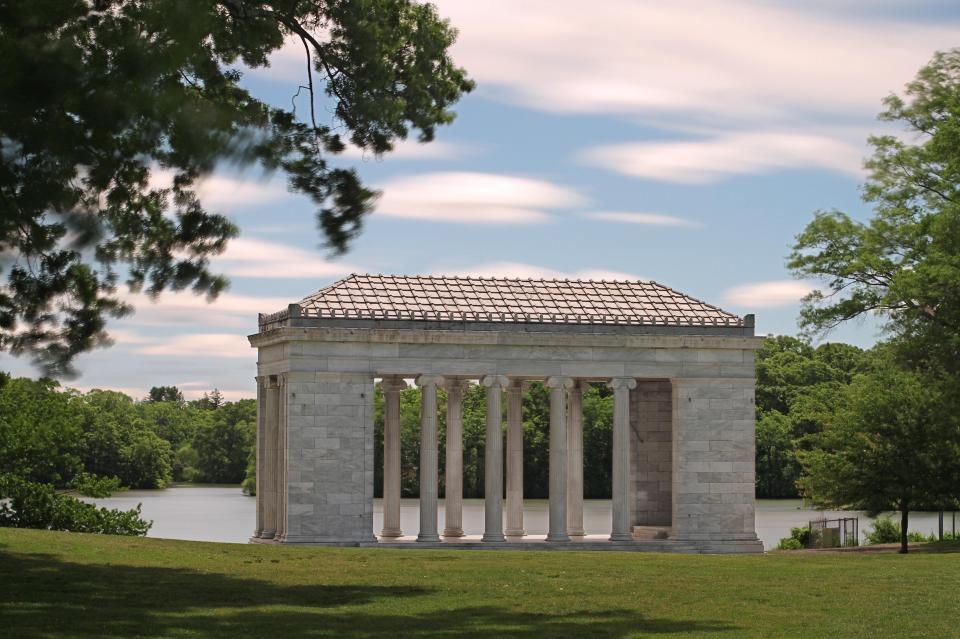The State House and Temple to Music are both RI landmarks. Do they use the same marble?
When it was time to build a State House, Rhode Island was in a position to flex a little bit.
With Rhode Island being the richest state per capita at the turn of the century, Lil’ Rhody's leaders wanted to build something grand when the project broke ground in 1895. And marble, which had dazzled in the White City display at the 1893 World's Columbian Exposition in Chicago, was the material everyone wanted.
Minnesota was using it to build its state capitol building, and Rhode Island was going to do the same, even if some businessmen in the area thought Rhode Island granite would be a better choice. McKim, Mead & White, the famed architects who won the bid for the project and who also happened to design a building for the Chicago fair, said marble was the way to go, and those with political power agreed that marble would be the most striking.
What and Why RI: How did Jerusalem and Galilee, Rhode Island, get their names? We asked around.
Well over 100 years later, the marble is still much discussed. There was a recent flurry of interest in it when Farm Fresh RI was selling offcuts of State House marble found in the dirt underneath their building. The state is in the process of cleaning the building to bring the marble back to its original glory. And, the building still holds the distinction of having the fourth-largest self-supported marble dome in the world, behind St. Peter’s Basilica, the Minnesota State Capitol and the Taj Mahal, in that order.
All the interest was bound to spark some curiosity, which brings us to this week’s What and Why RI question: Is the State House marble the same marble that was used at the Temple to Music in Roger Williams Park?
History of the State House marble
While the state did look into using marble from a quarry in the Lincoln village of Lime Rock, a Harvard professor who looked at samples of rocks from that quarry ruled it out because of quality concerns, according to The Providence Journal archives.
Instead, the state sourced the marble from Georgia. (As an aside, Georgia marble was in high demand after the Columbian Exposition and was also used for the Minnesota State Capitol.)
What and Why RI: It was called a blight on Rhode Island and then torched. Here's the story of Scalloptown.
The marble that went into the State House was carefully considered. In fact, about a year into the project some of the Board of State House commissioners raised such a fuss about the veining in some of the blocks used, declaring it too black and blue, that a representative had to go around the building with a red pen noting every block of marble that needed to be replaced because it wasn’t white enough, according to a Journal article about the debacle.
The State House was finished in 1904. While it was being constructed, McKim, Mead & White designed Rosecliff Mansion in Newport, as well as other prestigious buildings around North America.

What about the Temple to Music?
The Temple to Music, which was originally named the Monument to Music, was built years after the State House in 1924 and used a different marble.
The Temple to Music was a bequest from William Curtis Benedict, an olive merchant who had traveled to Greece many times for business. In his will, he set aside $75,000 to build a monument to music at Roger Williams Park to “instruct and adorn” and named a committee of people to make it happen.
What and Why RI: Rhode Island is known as the Ocean State. How did we get the nickname anyway?
Inspired by Benedict’s business interest in Greece, they decided on a classical Greek style for the building, according to a Providence Journal Sunday piece about the grand opening. And if you’re going to build a Greek-style building, the material of choice is going to be marble.
The Highland Danby white marble sourced for the project came from quarries in Proctor, Vermont.
What and Why RI is a weekly feature by The Providence Journal to explore our readers' curiosity. If you have a question about Rhode Island, big or small, email it to klandeck@gannett.com. She loves a good question.
This article originally appeared on The Providence Journal: RI State House marble's history is not shared by Temple to Music

